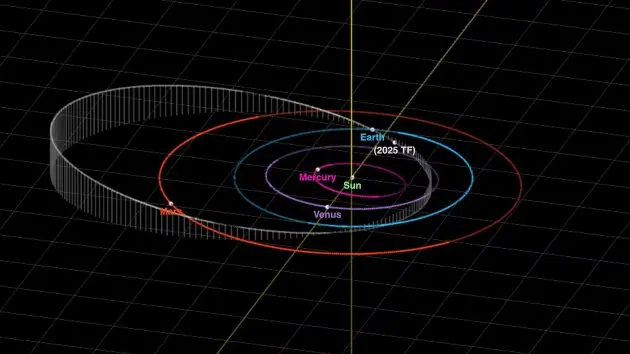
(NEW YORK) — An asteroid just flew closer to Earth than many satellites, according to space agencies.
The space object, named 2025 TF, zoomed over Antarctica at a distance of just 265 miles above the Earth’s surface last Wednesday, Oct. 1, at 8:47 p.m. ET, the European Space Agency said on Monday. The International Space Station orbits at a similar altitude.
The majority of satellites are low earth orbit, at altitudes between 100 miles and 1,242 miles, the research project Aerospace Security notes.
The small asteroid is between 3.2 feet to 9.8 feet across and didn’t pose significant danger to the planet, the ESA said. However, the agency noted that it could have produced a fireball if it struck Earth’s atmosphere and became a meteorite once it hit the ground.
Astronomers didn’t notice the asteroid until a few hours after it passed, according to the ESA. The Catalina Sky Survey, a mission funded by NASA to track near-Earth objects, first spotted the object. Shortly after that, it was observed by astronomers at the ESA’s Planetary Defence Office.
“Tracking down a metre-scale object in the vast darkness of space at a time when its location is still uncertain is an impressive feat,” the ESA said. “This observation helped astronomers determine the close approach distance and time given above to such high precision.”
The object is not expected to fly by Earth again until April 2087, according to NASA.
Another small asteroid — named 2025 TQ2 — flew within Earth’s vicinity the day after 2025 TF’s approach, according to the Minor Planet Center. The asteroid zoomed over Canada at a distance of about 3,014 miles last Thursday, Oct. 2, according to EarthSky.org.
Space agencies track thousands of near-Earth objects, but they are only considered Potentially Hazardous Asteroids if they are larger than 500 feet in diameter and get closer than 4.65 million miles of Earth, according to NASA’s Center for Near Earth Object Studies.
Between Sept. 23 and Sept. 28, 10 asteroids passed near Earth at a distance closer than the moon, according to data from NASA.
Copyright © 2025, ABC Audio. All rights reserved.




